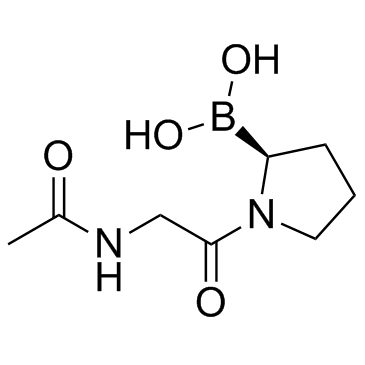| Description |
Ac-Gly-BoroPro is a selective FAP inhibitor with a Ki of 23 nM.
|
| Related Catalog |
|
| Target |
Ki: 23 nM (FAP)[1]
|
| In Vitro |
FAP has been implicated in cancer; however, its specific role remains elusive because inhibitors that distinguish FAP from other prolyl peptidases like dipeptidyl peptidase-4 (DPP-4) have not been developed. Ac-Gly-BoroPro selectively inhibits FAP relative to other prolyl peptidases. FAP reacts readily with submicromolar concentrations of Ac-Gly-BoroPro, reaching steady state inhibition levels rapidly (Ki=23±3 nM). In contrast, DPP-4 requires higher Ac-Gly-BoroPro concentrations for inhibition and a longer time to reach steady state inhibition levels (Ki=377±18 nM). Ac-Gly-BoroPro inhibits other prolyl peptidases (DPP-7, DPP-8, DPP-9, prolyl oligopeptidase, and acylpeptide hydrolase) with Ki values ranging from 9- to 5400-fold higher than that for FAP inhibition. The N-acyl-linkage in Ac-Gly-BoroPro blocks the N terminus of the inhibitor, making it less nucleophilic and therefore unlikely to cyclize[1].
|
| Kinase Assay |
Ki values for inhibition of proteases by Ac-Gly-BoroPro are determined using the method of progress curves for analysis of tight binding competitive inhibitors. Various concentrations of Ac-Gly-BoroPro are reacted with FAP (1.0 nM) and DPP-4 (0.1 nM) in the presence of Ala-Pro-AFC (500 μM for FAP; 100 μM for DPP-4), and time-dependent inhibition of each protease is monitored. Reactions contained inhibitor concentrations at least 20-fold greater than protease concentrations, such that the protease-inhibitor complex does not significantly deplete the free inhibitor[1].
|
| References |
[1]. Edosada CY, et al. Selective inhibition of fibroblast activation protein protease based on dipeptide substrate specificity. J Biol Chem. 2006 Mar 17;281(11):7437-44.
|
